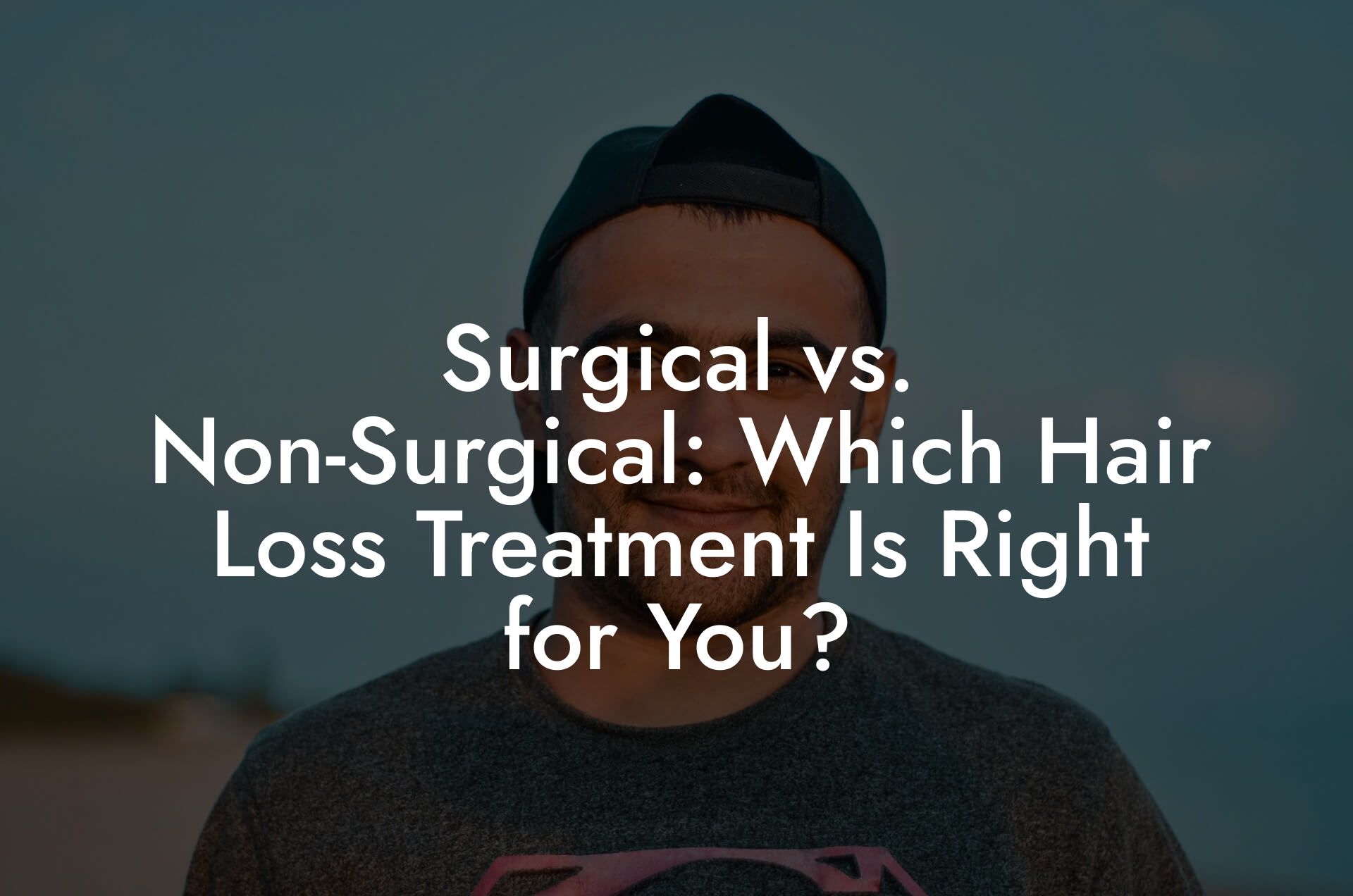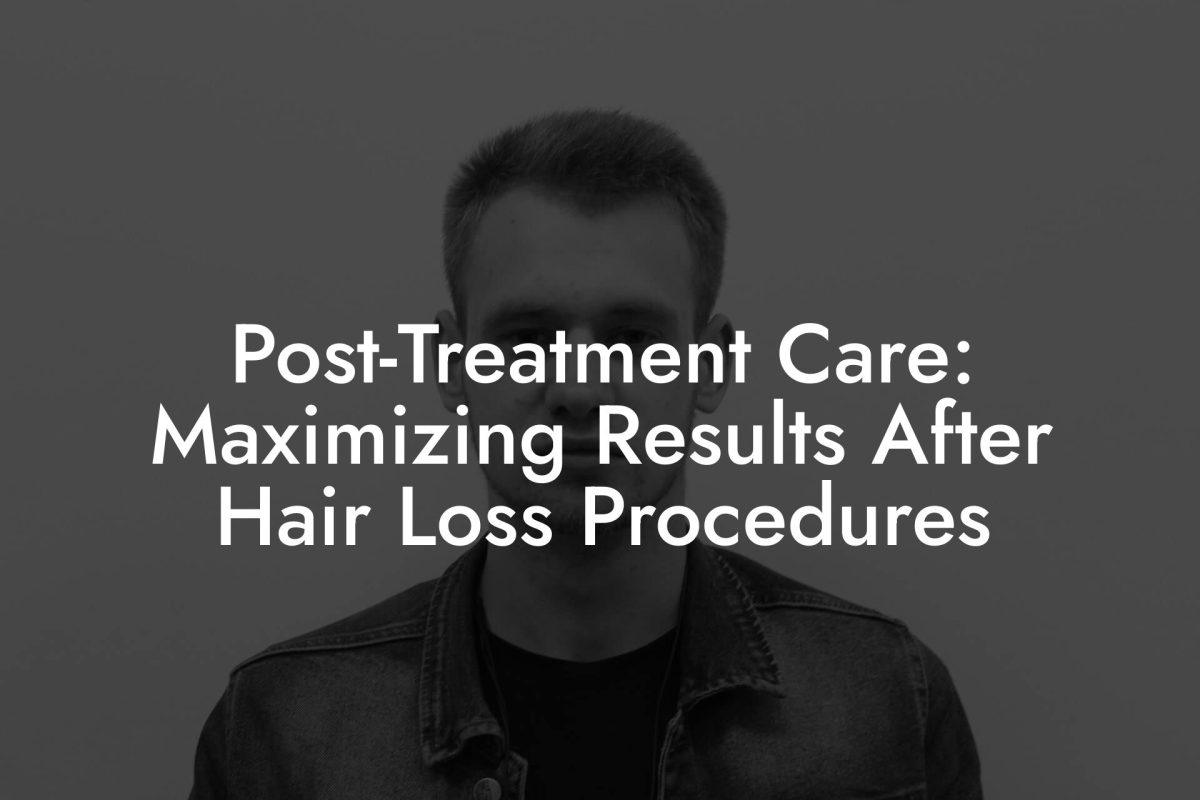Hair Loss Library
Surgical vs. Non-Surgical: Which Hair Loss Treatment Is Right for You?

Ever catch your reflection and wonder if that thinning hair is staging a silent rebellion? Welcome to the ultimate showdown: Surgical vs. Non-Surgical Hair Loss Treatments, where mane maintenance meets modern innovation. At Mane Matrix, we keep it real—no awkward doctor visits or sky-high fees, just straight-up expert analysis to help you reclaim your crown. Whether you're nodding off to the promise of a hair transplant or vibing with non-invasive solutions like PRP and laser therapy, this guide is your backstage pass to unlocking the secrets of hair restoration that resonate perfectly with the Gen Z and millennial spirit.
Understanding Hair Loss: More Than Just a Bad Hair Day
Before we dive into the nitty-gritty of surgical and non-surgical treatments, let's unpack what hair loss really is. Hair loss, clinically known as alopecia, isn’t merely about losing strands—it’s about losing a part of your identity. From genetic patterns to environmental stressors, the causes are as diverse as your Spotify playlist. And while society might sometimes joke about the “bald and bold” look, we know that for many, it’s more than just aesthetics—it’s a matter of confidence and self-expression.
So, whether you're dealing with male pattern baldness, receding hairlines, or thinning crown vibes, understanding your dilemma is the first step toward rocking a solution that feels uniquely you.
The Lowdown on Surgical Hair Loss Treatments
Let’s roll out the red carpet for surgical hair loss treatments—the heavyweight champs in the battle against baldness. These treatments involve a hands-on approach to help reboot your hair game. Think of them as the "makeover" procedures that give your scalp a fresh start, relocating robust hair follicles to the areas where you're experiencing hair loss.
What Exactly Is a Hair Transplant?
A hair transplant isn’t about magic or witchcraft—it’s high-precision surgery. In procedures like follicular unit transplantation (FUT) or follicular unit extraction (FUE), hair follicles are carefully harvested from areas with dense hair (your secret reservoir) and implanted in the barren zones. The goal? Stimulate natural growth that not only fills in the gaps but also gives you a fuller, more youthful look.
Pros of Surgical Treatments
- Long-Lasting Results: Once your transplanted hair settles in, it’s pretty much in it for the long run.
- Natural-Looking Outcomes: With modern techniques, even the most discerning mirror-checker will swear by your new ‘do.
- Permanent Solution: Unlike temporary fixes, surgical methods aim to permanently redistribute your hair follicles.
Cons of Surgical Treatments
- Cost Factor: Surgery isn’t a bargain; expect higher initial costs that may break the bank on a month-to-month budget.
- Downtime Required: Post-surgery recovery can take time, meaning you might have to put your hair game on pause.
- Not a One-Size-Fits-All: Results can vary and sometimes additional procedures might be needed.
Surgical treatments are like investing in an exclusive, high-end gadget: expensive upfront, but when it works, it transforms your experience and boosts your confidence.
Diving into Non-Surgical Treatments: The Modern Hair Revival
If the thought of surgery sends shivers down your spine (or makes you hesitate at the idea of a scalpel near your scalp), non-surgical treatments might be your new best friend. These therapies range from medicinal solutions to high-tech gadgets, offering less invasive alternatives that deliver impressive results without turning your life upside down.
Popular Non-Surgical Options
- PRP Therapy (Platelet-Rich Plasma): Imagine your own blood, armed with growth factors, being the secret sauce to stimulate hair growth. It sounds like something out of a sci-fi movie, but many swear by its regenerative properties.
- Low-Level Laser Therapy (LLLT): Using scientifically calibrated laser light, LLLT boosts blood circulation and awakens dormant hair follicles. Think of it as a gentle kickstart to your scalp’s natural rhythms.
- Topical Treatments and Medications: Ingredients like minoxidil and finasteride have been the go-to for many. They work to slow down hair loss and sometimes even trigger regrowth over a few months.
- Microneedling: This method uses tiny needles to create micro-injuries on the scalp, which then promotes healing and hair growth. It’s a bit like giving your scalp a spa day with a twist!
Pros of Non-Surgical Treatments
- Minimal Downtime: Treatments often require little to no recovery, so you can bounce back to your daily routine almost immediately.
- Cost-Effective Options: With many non-invasive treatments, you have a range of price options—from budget-friendly over-the-counter solutions to more premium therapies like PRP.
- Less Risky: Since there’s no surgery involved, the risks associated with anesthesia or infection are significantly reduced.
Cons of Non-Surgical Treatments
- Slower Results: Patience is key—visible improvements might take several months of consistent treatment.
- Maintenance Required: Many of these treatments are ongoing rather than one-time fixes, meaning a long-term commitment.
- Varied Effectiveness: Results can be inconsistent; what works wonders for one Person might yield average results for another.
In the world of non-surgical treatments, think of it like opting for a steady fitness regimen rather than a quick-fix surgery—gradual, consistent, and often complemented with lifestyle upgrades.
Surgical vs. Non-Surgical: The Ultimate Comparison
Choosing between surgical and non-surgical hair loss treatments is kind of like deciding between a transformative glow-up and a daily self-care routine. Both paths have their merits and challenges, and the right choice ultimately depends on your lifestyle, budget, ambitions, and even a pinch of luck with your genetics.
Factors to Consider
When weighing your options, ask yourself a few key questions:
- What Are Your Expectations? Are you dreaming of a dramatic, long-lasting change, or do you prefer a gradual improvement with minimal intervention?
- How Much Time Can You Invest? Surgical treatments require recovery periods and periodic follow-ups, while non-surgical ones might become a regular part of your routine.
- What’s Your Budget? If you're watching your wallet, non-surgical treatments might be budget-friendly in the short run, whereas surgery is more of a long-term investment.
- How Risk-Averse Are You? Surgery, even with modern techniques, comes with risks. Non-surgical methods are less invasive but require consistency and patience.
- What’s Your Hair Loss Stage? For early stages of hair loss, non-surgical interventions might suffice, but more advanced cases could benefit from the strategic redistribution of hair follicles that surgery offers.
Considering these questions can help you align your expectations with a treatment plan that fits your unique needs. Remember, there’s no “one-size-fits-all”—what matters most is finding a balance that allows you to feel confident and look your best.
The Pros and Cons: A Head-to-Head Breakdown
Let’s break it down in a way that’s as straightforward as a tweet:
| Aspect | Surgical Treatments | Non-Surgical Treatments |
|---|---|---|
| Speed of Results | Typically faster, with noticeable improvement post-healing. | Gradual; may take months before significant changes are visible. |
| Longevity | Permanent, with transplanted hair growing naturally. | Often requires ongoing maintenance and periodic treatments. |
| Risk Level | Higher risk due to surgery and potential complications. | Lower risk, non-invasive with minimal recovery time. |
| Cost | Generally higher initial expense but long-term value. | Lower entry cost, but cumulative expenses may add up over time. |
| Commitment | One-time (or occasional) procedure with recovery time. | Ongoing commitment with regular sessions or applications. |
Whether you lean toward the bold promise of a hair transplant or the steady drip of non-surgical therapies, both are valid paths—each with its own story to tell. Choose the one that vibes with your personality and fits your lifestyle like your favorite pair of sneakers.
Who Can Benefit from Surgical Hair Loss Treatments?
Surgical treatments are a game-changer for those who've reached an advanced stage of hair loss and are ready to invest in a lasting solution. They work best for individuals who:
- Have sufficient donor hair available, typically from the back of the head.
- Experience significant, patterned hair loss in distinct areas like the crown or receding hairline.
- Prioritize a natural, permanent look over temporary fixes.
- Are comfortable with a recovery period and the surgical process.
In essence, if you're looking for a transformative, one-and-done kind of upgrade and are ready to commit to some downtime for long-term benefits, surgical treatments might just be your new best friend.
Who Thrives on Non-Surgical Treatments?
Non-surgical treatments are ideal for those in the early to moderate stages of hair loss, or anyone who isn’t down for surgery. These approaches are perfect if:
- You’re looking for a low-risk, non-invasive solution that fits snugly into your busy lifestyle.
- A gradual, consistent improvement appeals more than a dramatic overnight change.
- You prefer treatments that can be adjusted and combined based on the evolving needs of your hair.
- Maintenance is not an issue, and you’re open to supplementing your routine with lifestyle changes.
Non-surgical methods allow you to stay in control without the stress of a one-time, major procedure—like upgrading your streaming subscription plan one step at a time.
The Future of Hair Loss Treatments: What’s on the Horizon?
Innovation in hair restoration is moving at warp speed, making the future look as bright as your soon-to-be-revived locks. Researchers and clinicians are working on groundbreaking treatments that merge technology and biology in ways we once thought belonged in a sci-fi saga.
New treatments are focusing on:
- Stem Cell Therapy: Using your body’s own regenerative cells to promote hair growth—a promising frontier for those wanting natural restoration.
- Gene Editing Solutions: Targeting the root causes of hair loss at a genetic level, potentially halting or reversing the process entirely.
- Advanced Laser Techniques: The next generation of low-level laser devices that deliver more focused, efficient treatment with even fewer sessions.
- Combination Therapies: Integrating surgical and non-surgical methods for a custom approach that adapts as your hair evolves.
The takeaway? Whether you opt for a surgical fix now or choose a non-invasive routine, keep an eye out—tomorrow’s breakthrough might just redefine the game entirely.
How to Choose the Right Hair Loss Treatment for You
At the end of the day, the decision between surgical and non-surgical hair loss treatments boils down to you—your lifestyle, your timeline, and your vision for your hair. Here’s a quick guide to help you decide:
Step 1: Evaluate Your Hair Loss Stage
Take a good, honest look in the mirror. Are you noticing a receding hairline or thinning crown, or is your hair loss more advanced? Early intervention with non-surgical treatments might be all you need, while more significant loss could benefit from the definitive approach offered by surgery.
Step 2: Assess Your Lifestyle and Priorities
Do you prefer a non-invasive routine that fits seamlessly into your daily schedule, or are you ready to invest time and energy into a surgical procedure with promising long-term results? Your lifestyle and work commitments play a big role in that decision.
Step 3: Understand Your Budget
Money matters. Surgical procedures come with a heftier price tag upfront, but they’re typically a one-time investment. On the other hand, non-surgical methods can incur ongoing costs. Factor in not just the price, but the value you’ll get over time.
Step 4: Do Your Homework
Research the treatments, consult with experts, and read reviews from people who have walked the same journey. At Mane Matrix, we believe that being informed is empowering, and that applies here, too. Your future mane deserves the best care possible.
Step 5: Consult the Experts
When in doubt, talk to professionals who can help you weigh the science, costs, and potential results. A candid consultation can provide insights that help you align your choices with your expectations.
There’s no right or wrong answer—only the solution that feels right for you. Invest in yourself by making an informed choice that elevates your confidence every day.
Resources and Community Support: Your Next Steps
Navigating the world of hair restoration doesn’t have to feel like a solo mission. Connecting with a community of like-minded individuals, expert advice, and firsthand success stories can make all the difference.
Here are some ways to keep the momentum rolling:
- Engage with Online Forums: Places like Reddit, specialized Facebook groups, and hair loss communities are overflowing with tips, firsthand experiences, and support from those who have been where you are.
- Follow Expert Blogs and Vlogs: Stay up-to-date with the latest breakthroughs, treatment reviews, and expert advice by following thought leaders in the hair restoration space.
- Utilize Mane Matrix’s Analysis Tools: Our website provides detailed, confidential, and embarrassment-free insights into your hair loss, helping you make informed decisions without the hassle of traditional consultations.
- Attend Webinars and Live Q&A Sessions: Get your burning questions answered directly by professionals and fellow survivors of hair loss. These interactive sessions often provide tips and tactical advice to help you decide on your next steps.
- Explore Support Groups: Whether online or in person, support groups offer motivation, accountability, and a sense of belonging. Share your journey, celebrate milestones, and learn from each other in a judgment-free space.
Empowerment often comes from community. By connecting with others who are on a similar journey, you’ll find encouragement, real-world insights, and the push you need to decide confidently between surgical and non-surgical solutions.
Real-Life Transformations: Stories That Inspire
The proof is in the pudding—or in this case, the hair! Countless individuals have walked the path of transformation, whether by opting for surgical interventions or embracing non-surgical routines. Let’s dive into a few real-life stories that might just make you feel, “Hey, that could be me!”
The Surgical Success Story
Mark, a 38-year-old tech entrepreneur, decided that enough was enough when his once-thick mane started to betray him. After thorough research and several consultations, he opted for an FUE hair transplant. Despite a few weeks of post-surgery downtime (hello, eccentric head-covering caps), he was thrilled with the natural results that gradually came to light. Now, Mark’s confident swagger isn’t just about his innovative startups—it’s about his head held high, thanks to a hair restoration that stood the test of time.
The Non-Surgical Journey
Then there’s Leo, a 29-year-old creative spirit whose hectic schedule left little time for invasive procedures. Choosing a non-surgical route with regular sessions of PRP therapy combined with a dedicated at-home regimen of topical treatments, Leo began seeing consistent improvements over several months. His journey wasn’t an overnight miracle, but each incremental gain kept him motivated. Today, Leo credits his revitalized hair (and renewed confidence) to a regimen that perfectly blends modern science with lifestyle convenience.
These stories remind us that every journey is unique. Whether you’re leaning toward the definitive results of surgical treatment or the steady promise of non-invasive care, success is forged by persistence, informed decision-making, and the courage to embrace change.
Your Personal Roadmap to Hair Restoration
Creating your personalized hair loss treatment roadmap is like curating the ultimate playlist—it should reflect your mood, style, and the journey you want to embark upon. Here’s how you can craft a plan that resonates with you:
Step 1: Take Stock
Start with an honest self-assessment. Keep a journal of your hair loss patterns, lifestyle factors, and what you hope to achieve. Visual documentation can help you identify trends and the best times to seek professional advice.
Step 2: Explore Your Options
Dive into research—read articles, watch expert interviews, and even connect with people on similar journeys. Whether it’s the promise of a surgical transplant or the appeal of recurring non-surgical sessions, each option brings its own flavor to your transformation.
Step 3: Set Achievable Goals
Define what success looks like for you. It might be as simple as slowing hair loss, or it could involve seeking full restoration. Clear, attainable goals will not only keep you focused but also provide a way to celebrate each milestone along the journey.
Step 4: Plan Your Next Steps
Armed with research and real-life insights, make the call that feels best for you. Remember, there’s no rush—your hair journey is a marathon, not a sprint. Whether the plan calls for a surgical boost or is centered on consistent non-invasive care, commit to a schedule that syncs with your lifestyle and ambitions.
This personalized roadmap isn’t static. As you progress, don’t be afraid to tweak and adjust your strategy. After all, the ultimate goal is for you to feel confident, empowered, and ready to take on every challenge that comes your way.
Frequently Asked Questions About Hair Loss Treatments
We know that when it comes to your hair, doubts and questions can spike faster than you can say “bald spot.” Here are some of the most common questions about surgical and non-surgical hair loss treatments answered in a straightforward, no-fluff style.
1. What is the main difference between surgical and non-surgical hair loss treatments?
Surgical treatments, such as hair transplants, involve moving hair follicles from a donor site to thinning areas, offering a permanent solution. Non-surgical treatments—like PRP therapy, low-level laser treatment, and topical medications—work by stimulating your existing hair and slowing hair loss over time.
2. How long before I see results from a hair transplant?
It typically takes several months before the transplanted hair starts growing, with significant results appearing around 9 to 12 months post-surgery. Patience is key—think of it like waiting for the perfect season drop of your favorite series!
3. Are non-surgical treatments effective for everyone?
Non-surgical treatments can be highly effective for many users, especially in the early stages of hair loss. However, effectiveness can vary depending on the individual’s hair loss pattern, genetics, and consistency with the treatment regime.
4. What are the potential side effects of surgical hair loss treatments?
While surgical hair transplants are generally safe, possible side effects include temporary swelling, mild pain, or minor infections. These are typically short-term and manageable with proper post-procedure care.
5. How do I know which treatment is right for me?
The best route depends on factors like the stage of hair loss, budget, lifestyle, and personal preferences. A thorough consultation with a hair restoration specialist (or using expert analysis tools like those at Mane Matrix) can help tailor the best treatment plan for you.
6. Can I combine both surgical and non-surgical treatments?
Absolutely! Many individuals opt for a hybrid approach—surgical procedures to restore volume, followed by non-surgical maintenance treatments to enhance overall hair health.
7. What is PRP therapy and how does it work?
PRP (Platelet-Rich Plasma) therapy involves drawing a small amount of your blood, processing it to isolate growth factors, and reintroducing it into your scalp to stimulate hair growth. It leverages your body’s natural healing processes.
8. Are the results from hair transplants permanent?
Yes, the transplanted hair follicles are typically resistant to the causes of hair loss, giving you a more permanent solution. However, natural hair loss might still occur in other non-transplanted areas, so ongoing care is often recommended.
Have more questions? Consider reaching out to experts or joining online communities where real people share their experiences and insights.
Your Journey to a More Confident You
At the end of the day, choosing between surgical and non-surgical hair loss treatments is a personal journey—a blend of science, intuition, and a dash of adventure. Whether you opt for the transformative promise of a hair transplant or the steady, non-invasive approach of modern therapies, remember that your decision is about more than just hair. It’s about regaining confidence, embracing change, and owning your unique style.
The road to hair restoration might seem long and winding, but every step you take is a victory in reclaiming what matters most: you. With expert insights from Mane Matrix and the supportive community by your side, your hair journey is set to become a story of empowerment, transformation, and, ultimately, self-love.
So, go ahead—make the call that resonates with your lifestyle, trust your instincts, and take that leap of faith. Your mane, your rules. Shine on, because the next chapter of your hair story starts now.
If you loved this article... Dive deeper into the world of mens hair loss with our most popular sections. If there is anything you think is missing or anything you would love for us to write about, just give us a shout.
Prescription Solutions: The Best Medications for Men’s Hair Loss
Minoxidil & Beyond: Exploring Topical Treatments for Hair Regrowth
How Finasteride Works: The Science Behind This Hair Loss Blocker
Platelet-Rich Plasma (PRP) Therapy: Is It the Answer to Hair Loss?
Hair Transplant 101: A Beginner’s Guide for Men
Exploring Laser Therapy: Non-Invasive Options for Hair Regrowth
The Pros and Cons of Oral Hair Loss Medications
New Frontiers in Hair Loss Treatment: Stem Cell Therapy Explained
Surgical vs. Non-Surgical: Which Hair Loss Treatment Is Right for You?
Understanding Combination Therapy for More Effective Hair Regrowth
How to Choose the Right Hair Loss Clinic: Expert Tips
Exploring Off-Label Treatments: What’s Worth Trying for Hair Loss?
Managing Side Effects: What to Expect from Hair Loss Medications
The Latest in Hair Loss Research: Emerging Medical Treatments
Microneedling for Hair Loss: Benefits, Risks, and Results
How PRP Therapy Boosts Hair Growth: A Closer Look
The Role of DHT in Hair Loss and How Medications Counteract It
Customized Treatment Plans: Tailoring Hair Loss Solutions for You
Understanding Clinical Trials: How New Hair Loss Treatments Are Tested
Breaking Down the Cost of Hair Loss Treatments: Is It Worth It?
How to Prepare for a Hair Transplant: A Step-by-Step Guide
Post-Treatment Care: Maximizing Results After Hair Loss Procedures
A Doctor’s Perspective: When to Consider Medical Hair Loss Treatments
Success Stories: Real Men Share Their Hair Restoration Journeys
The Future of Medical Hair Loss Solutions: Trends to Watch
















